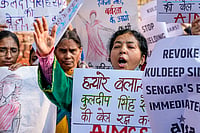Another telecom revolution is in the offing. This time you can pick up the phone and dial anywhere—local or STD, the rates will be the same. Slimmer phone bills and a huge increase in calls are assured. But mind you, it's bound to hurt some of the existing operators. This, in a nutshell, will be the overall impact of the ambitious IndiaOne plan mooted by Union communications minister Dayanidhi Maran. "Let's face it, IndiaOne is possible. And the UPA government will make sure it's implemented soon," says a confident Maran.
What IndiaOne envisages is a uniform tariff across the country. In other words, it seeks to convert the country into a local call regime. It won't matter whether you're calling within Delhi or from Delhi to Amritsar, Calcutta, Chennai or Panjim. It won't matter whether you call from a landline to landline, mobile to mobile, or mobile to landline—all calls will be charged at the same basic rate offered in your tariff plan. Obviously, the actual rates will be higher because of the charges operators pay for using the telecom infrastructure that's not owned by them.
Although the actual tariff is yet to be unveiled, there are two possible scenarios. In the first case, the basic rate for all calls could be Rs 1.75-1.80 for three minutes. While this will increase local call rates—currently at Rs 0.80 per minute—it may drastically reduce STD basic rates (between Re 1 and Rs 2.65 per minute depending on the distance). A more likely framework may be that while consumers pay the same for local calls, STD rates will come down to Rs 1.80-Rs 2.
But Maran has initiated quick moves to ring in IndiaOne. Recently, the department of telecommunications (DOT) announced that intra-state calls in four states—Tamil Nadu, West Bengal, Maharashtra and Uttar Pradesh—would be treated as local calls. Last week, it decided to remove a major obstacle in the way of IndiaOne. The proposal to compensate state-run BSNL for use of their infrastructure by private players in the form of revenue-sharing rather than a fixed rate is awaiting the pmo's nod. Maran has also promised that "artificial barriers" hampering IndiaOne will be removed through suitable changes in the existing telecom policy.
The plan has resulted in deepening fissures between the various operators. The CDMA mobile players are against the proposal. On the other hand, most of the GSM mobile firms seem to be supporting Maran—though the largest among them, Bharti, could be affected as IndiaOne could dent its revenues and profits. State-owned BSNL is struggling to find ways to accommodate the minister's wishes although it'll possibly be the worst affected party. Expectedly, it has led to intense lobbying by all the players to influence the nitty-gritty and the fine print of the IndiaOne scheme.
Says S.C. Khanna, secretary general, Association of Unified Telecom Service Providers of India (AUSPI), which represents the CDMA firms, "We don't favour IndiaOne. If things in the sector were moving in the right direction, why disturb it with such a move? There is no reason to whip the horse which is already performing." Khanna's ire is understandable since CDMA firms like Reliance offer a IndiaOne-like service to subscribers. All Reliance-to-Reliance calls are billed at local rates. So, if IndiaOne becomes a reality, AUSPI members will lose their competitive edge over GSM rivals.
Naturally, the Cellular Operators Association of India (COAI, comprising GSM firms, supports IndiaOne. Explains COAI's director general T.V. Ramachandran, "Local calls should be kept out of IndiaOne. Otherwise local call rates will increase which will be anti-consumer." What he's advocating is a dual tariff regime whereby local calls are charged at current rates and STD rates come down.
Ramachandran thinks the high carriage charges paid to firms that hold a long-distance licence will have to reduce to enforce the IndiaOne regime.At present, the carriage charge is a high Rs 1.10 per minute and COAI feels it should come down to around 50 paise. Integrated players like Bharti, which incidentally is also a GSM operator and part of COAI, will stand to lose revenues in case carriage charges are cut.
The biggest loser, however, will be BSNL, which operates in all states, is the largest long-distance player and records huge revenues from the more expensive long-distance calls. A.K. Sinha, CMD, BSNL, agrees and adds that the psu "was analysing the likely impact" due to IndiaOne. In the same breath, he cautions that BSNL may have no option but to raise the tariff on local calls in case the revenue implications were significant. Maran will have to look after BSNL's interests before launching IndiaOne.
There are other issues that the telecom ministry will have to thrash out. At present, only the national long-distance operators are allowed and licensed to carry STD calls. Under the new plan, this will have to change or else it will lead to litigations as the long-distance players have paid huge licence fees and would expect to be compensated for losing the carriage exclusivity. In fact, the licensing regime may have to be scrapped. The issue of additional spectrum may also come up as IndiaOne could lead to a surge in traffic.
Operators, on the other hand, would have to enter into fresh interconnect agreements with each other to enable a seamless transfer of calls across all circles and states. Clearly, such arrangements will take time and the process may not be entirely smooth. Problems between the private players and the state-owned BSNL have remained unresolved for years.
Given the complexity involved, Maran is playing safe. In fact, his ministry has not spelt out any details. Sources contend the government is likely to finalise the proposal in the next few weeks. But since Maran seems obsessed with IndiaOne, it'll only be a matter of time before it becomes a reality. Unless, the affected corporates manage to cut the wire.
Dial 1 For India
A flat rate for STD or local calls. But the proposal could ruffle many feathers.

Dial 1 For India
Dial 1 For India
Published At:
MOST POPULAR
WATCH
MORE FROM THE AUTHOR
×

















